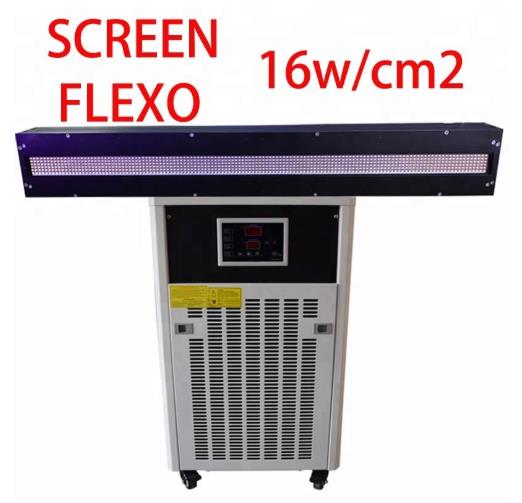Principle and characteristics of semiconductor UV LED photocuring machine :
1.Energy saving, cost reduction. When the light reaches a certain brightness due to the exposure of semiconductor of UV LED, the energy consumption is only 15 watts. Conventional light to achieve the same brightness uses 1500 watts of energy, and even ultraviolet halogen ratios can save 80% of that energy.
2.LED lamp is not infrared light heating, and the low heat release of UV LED curing machine will not affect the easy heating and deformation of media (such as foam board, foil, PVC, etc.) during printing.
3.Fast reaction time. LED lights do not need to preheat, after printing can be turned on immediately to improve productivity.
4.High safety and high stability. There is a great relationship between UV inkjet printing quality and the drying process of UV LED photocuring machine in the stability of LED lamp.
Examples of application of UV LED photo curing lamp technology :
The applications of UV LED photo curing lamp is very extensive. Its applications have a big connection with people’s more and more in-depth research. From exposure, curing to the current high-tech applications, UV LED light curing lamp technology is a qualitative leap.
Ultraviolet photons have a tremendous amount of energy. When molecules excite fluorescence, when ultraviolet radiation reaches many substances, this phenomenon is called the fluorescence effect of ultraviolet light. When ultraviolet light hits certain substances, these substances are selectively absorbed and emit different wavelengths and intensities of visible light. Fluorescence on the surface of a substance reflects its properties, allowing it to be qualitatively and quantitatively analyzed. When ultraviolet radiates fibers, different fluorescence emission can be detected due to different properties and of fiber.
The energy of UV varies according to the length of wavelength, and its energy is basically the same as the chemical binding energy of most organic materials. When the energy exceeds the chemical binding energy of polymer, the molecular chain of the polymer fiber will crack. In a aerobic atmosphere, the oxygen molecules will enter ozone, reactive oxygen, and the polymer fiber materials will be oxidized. The hydrophilicity, hygroscopicity and antistatic properties of polymer fiber materials were improved by introducing polymer fiber materials into polar groups. Deodorizing and antibacterial substances are introduced, which can make polymer fiber materials have deodorant and antibacterial agents. The effects of ultraviolet rays on fibers occur at only a few tens to thousands of angles to the surface of the fibers, and thus do not affect the basic physical and mechanical properties of the fibers.
At present, the inkjet printing technology used in ink is mainly water-based ink and solvent-based ink. The application and development of water-based ink have been basically mature. The disadvantage of water-based ink is long drying time and low adaptability to substrate. Solvent-based ink has no drying problem, but volatile organic solvents are easy to cause environment pollution. So the use is limited. In order to avoid the above ink defects, UV curing technology was introduced into inkjet. UV LED photocuring ink uses photoactive prepolymer as ink substrate. Under ultraviolet radiation, the photoinitiator generates free radicals that cause the substrate to polymerize and cross-link, turning ink from liquid to solid and solidifying. The same mechanism can also be applied to UV curing adhesive, UV curing coating sheep, wool fabric curing shrinkage treatment technology.
Inkjet printing technology is a new product of UV LED light curing lamp, its demand is growing, not the traditional advantages of printing technology.It's going to develop very quickly.
